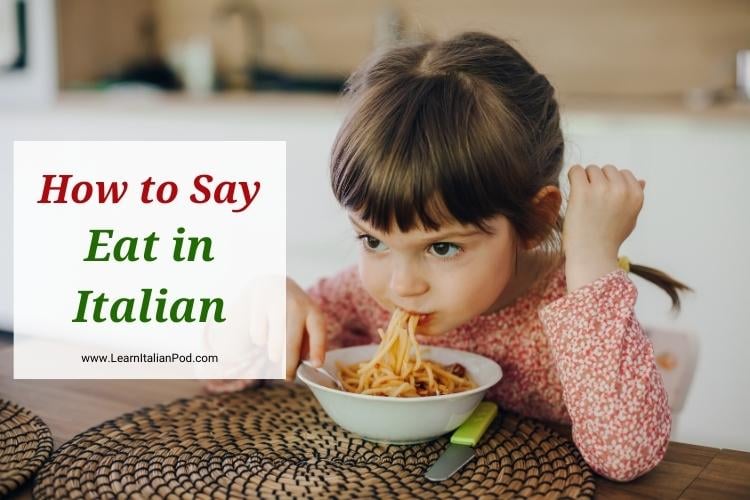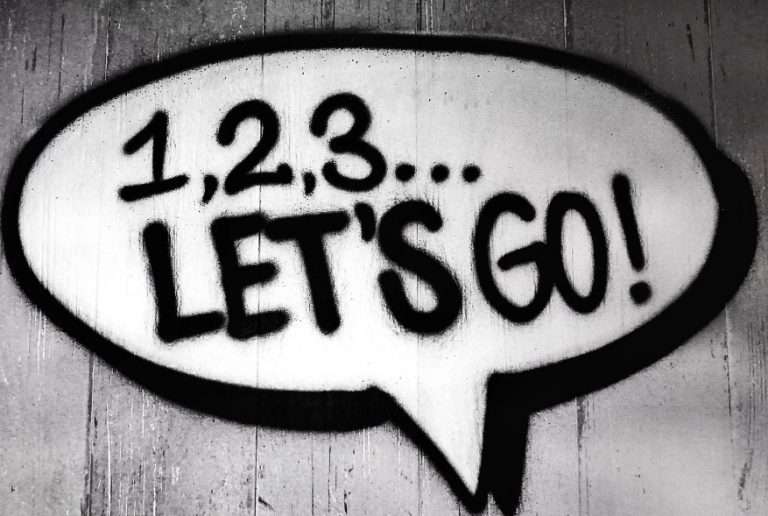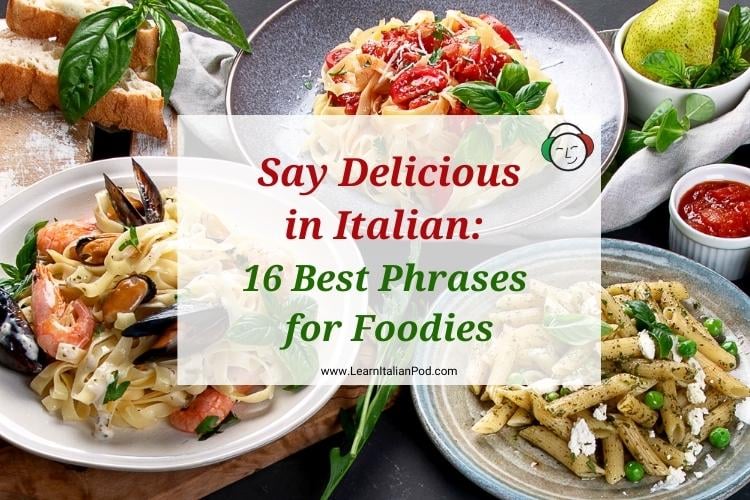How to Say Eat in Italian: Your Guide to Mangiare
Looking to learn how to say eat in Italian? You’re in the right place!
Italy, a country renowned for its culinary delights, offers a rich language full of expressions related to Italian food and eating.
This comprehensive guide will delve into the many ways to say eat in Italian, covering various expressions, eating habits, meal times, and the all-important verb mangiare (to eat).
Exploring the Verb Mangiare: The Italian for To Eat

At the heart of our exploration is the verb mangiare, which is the primary way to say “to eat” in Italian. It is a regular verb ending in “-are.”
As any language-learning program will emphasize, mastering verbs is crucial to gaining proficiency.
Here’s how you conjugate the transitive verb “mangiare” in the present, past, and future tenses.
Present Tense
| Italian | English |
|---|---|
| Io mangio | I eat |
| Tu mangi | You eat |
| Lui/Lei mangia | He/She eats |
| Noi mangiamo | We eat |
| Voi mangiate | You (plural) eat |
| Loro mangiano | They eat |
Past Tense (Past Participle)
| Italian | English |
|---|---|
| Io ho mangiato | I ate |
| Tu hai mangiato | You ate |
| Lui/Lei ha mangiato | He/She ate |
| Noi abbiamo mangiato | We ate |
| Voi avete mangiato | You (plural) ate |
| Loro hanno mangiato | They ate |
Note: This is the past participle or “passato prossimo” of “mangiare”. It uses the “participio passato” of the verb “mangiare”, which is “mangiato”.
Future Tense
| Italian | English |
|---|---|
| Io mangerò | I will eat |
| Tu mangerai | You will eat |
| Lui/Lei mangerà | He/She will eat |
| Noi mangeremo | We will eat |
| Voi mangerete | You (plural) will eat |
| Loro mangeranno | They will eat |
Planning a trip to Italy and need language help? Explore our essential Italian phrases for travelers, which includes a handy PDF cheat sheet.
How to Order Food in Italian at a Restaurant

Ordering food in an Italian restaurant can be an enjoyable and engaging experience. Here’s an 8-step guide packed with useful phrases on how to order delicious food in an Italian restaurant.
1. Start with a greeting
Upon entering an Italian eatery, it’s traditional to acknowledge the staff with a “buongiorno” (good morning/afternoon) or “buonasera” (good evening).
2. Request a table
If you haven’t pre-booked, you can request a table by saying “vorrei una tavola per due, per favore” (I would like a table for two, please).
3. Order drinks
To order drinks, you can say “vorrei un bicchiere di vino rosso/vino bianco della casa” (I would like a glass of red wine/white wine) or “vorrei una birra” (I would like a beer).
To order a glass of house wine, say ” un bicchiere di vino della casa.”
4. Order delicious food
In Italian restaurants, the verb “prendere” (to take) is frequently used to place food orders. You can say “prendo la pasta alla carbonara” (I’ll take the carbonara pasta) or “prendo la lasagna alla bolognese” (I’ll take the Bolognese lasagna).
5. Ask for recommendations
If you’re uncertain about what to choose, you can ask “il cameriere” (the waiter) for suggestions by inquiring, “cosa mi consiglia?” (what do you recommend?).
6. Specify your preferences
If you have any dietary limitations or preferences, you can request alterations to the dish. For instance, you can express “vorrei la pasta con olio di oliva” (I would like the pasta with olive oil).
7. Order a dessert
After completing your main course, you can order dessert by stating, “vorrei la panna cotta” (I would like the panna cotta) or “prendo il cannolo siciliano” (I’ll take the Sicilian cannoli).
8. Ask for the check
When you’re prepared to leave, you can ask for the check by saying, “il conto, per favore.” And while you’re settling your bill, get to know about Coperto in Italy – our guide sheds light on this unique cover charge and tipping etiquette.
Italian Expressions for Let’s Eat and Enjoy Your Meal
Beyond the verb “mangiare,” there are several ways to express the act of eating and enjoying a meal. Here are a few useful Italian phrases.
- Buon appetito – Similar to the French “bon appetit,” this phrase is used to wish someone an enjoyable meal.
- Mangia! – This Italian word, which is the most straightforward way to say “eat,” is actually the imperative conjugation of the word “mangiare.” It’s often used in informal settings and among close friends or family.
- Mangiamo! – This is the plural of “mangia,” and that’s the equivalent of the English expression “let’s eat!”.
Think you know traditional Italian cuisine? Put your knowledge to the test with this traditional Italian cuisine trivia quiz.
Italian Meals Throughout the Day

Just like in English, Italians have specific words for different meals throughout the day. However, the way they approach these meals can be quite different from other cultures.
Let’s review the most common words Italians utilize to characterize their diverse meal times across the day.
La Colazione: Breakfast
Breakfast in Italy, known as “la colazione,” is typically swift and uncomplicated. The meal often starts with a coffee, either an espresso or a cappuccino, and is accompanied by a sweet pastry or biscuit.
Contrary to the substantial breakfasts customary in other cultures, Italians favor a simple and light start to their day.
The phrase “fare colazione,” which translates to “doing breakfast,” is commonly used instead of “mangiare la colazione” (eating breakfast). This reflects the Italian approach to breakfast as an activity rather than just a meal.
A traditional Italian breakfast seldom finds savory items or proteins such as eggs and bacon. This further emphasizes the simplicity and lightness of the first meal of the day in Italy.
Il Pranzo: Lunch
“Pranzo,” or lunch, is considered the most important meal of the day in Italian cuisine. It’s usually the largest meal, typically served between 1 pm and 2 pm.
A traditional Italian lunch consists of several courses starting with an “antipasto” (Italian for appetizer), followed by a “primo” (first course), usually pasta, a “secondo” (second course) of meat or fish, a side dish, and finally an Italian dessert or fruit.
Of course, this varies greatly depending on the region and whether it’s a weekday or weekend.
During weekdays, many Italians have a more simplified version of lunch due to work. This is often called “la pausa pranzo” (lunch break).
Suggested Read: School Lunch in Italy: What Italian Kids Eat Midday
La Merenda and Lo Spuntino: Snack
La Merenda (snack) is a traditional Italian snack time that usually takes place in the afternoon, often to tide children over between lunch and the late Italian dinner. It typically consists of a simple, light fare such as a piece of fruit, a yogurt, or a small sandwich.
Another term for a snack in Italian is “spuntino.” While “merenda” is more often associated with children, the Italian word “spuntino” is used more broadly for any small, between-meal snack.
It can be enjoyed at any time of the day whenever one feels a bit peckish. Many Italians like to “fare uno spuntino” (have a spuntino) with a “pizza al taglio” (a slice of pizza).
L’Aperitivo: Aperitif (Happy Hour)
L’aperitivo is a pre-dinner ritual in Italy, similar to what many know as “happy hour.” It’s a social event that takes place at bars and cafes where friends and colleagues gather to relax and chat before dinner.
The word “aperitivo” comes from the Latin word meaning “to open,” and the idea is that the drink opens your stomach to prepare for dinner.
Recommended Reading: 10 Famous Latin Quotes and Meanings: Ancient Italian Wisdom Unveiled
The Italian happy hour usually involves a light alcoholic beverage, such as a spritz or a glass of wine, accompanied by small light snacks like olives, chips, and nuts.
La Cena: Dinner
“Cena,” or dinner, is usually a lighter meal, served later in the evening, around 8 pm or even later. It often consists of a single course, such as pasta or a meat dish, accompanied by a side of vegetables.
However, if lunch was light, dinner might be more substantial. It’s also common for Italians to gather with friends or family for a longer, leisurely dinner, especially on weekends or special occasions.
Lo Spuntino di Mezzanotte: Midnight’s Snack
“Lo Spuntino di Mezzanotte” literally translates to “the midnight snack.” This is not a common daily occurrence but is more associated with special occasions or late-night socializing.
After a night out at the theatre, a concert, or a party, Italians might stop for a “spuntino di mezzanotte” before heading home.
This late-night snack could be something simple like a panino, a slice of pizza, or even the famous “spaghetti di mezzanotte” (the midnight spaghetti).
Italians take their time to savor the food in all meals and engage in conversation. Eating is seen not just as a physical necessity but also as a social event, a moment to relax and enjoy the company of others.
This approach to meals is a key aspect of the Italian concept of “la dolce vita” or “the sweet life.”
Phrases About Eating a Lot
Sometimes, you might want to express the idea of eating a lot or indulging in a feast. Here are some useful Italian phrases.
- Abbuffarsi – This verb translates to “to stuff oneself,” often used when someone eats a lot in one sitting.
- Ci siamo abbuffati tanto – This sentence translates as “We stuffed ourselves very much.”
Adverbs Associated with Eating
Italians employ adverbs to depict the manner or location of eating. Here are a few examples, including the common expression “mangiare fuori” (to eat out).
- Mangiare fuori – Eating out.
- Mangiare piano – Eating slowly.
- Mangiare tanto – Eating a lot.
- Mangiare niente – Eating nothing.
Related Reading: How to Say Yes in Italian: Best 41 Ways (w. Audio)
Inviting People to Eat
Italians have a few ways to invite others to join when it’s time to eat. Here are some examples.
- È ora di mangiare – It’s time to eat.
- Andiamo a mangiare – Let’s go eat.
- Tutti a tavola! – Everybody to the table!
Meal Times in Italy
In Italy, meal times are quite structured. Breakfast, or “colazione,” is usually light and early. “Pranzo,” or lunch, is the day’s main meal, typically around 1 pm. Dinner time, or “cena,” is usually lighter and served later in the evening, around 8 pm.
Final Thoughts
Understanding how to say eat in Italian and related expressions and phrases can enrich your language skills and enhance your cultural understanding.
Whether you’re planning a trip to Italy or simply learning the language, these phrases will surely come in handy. Buon appetito!







